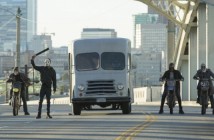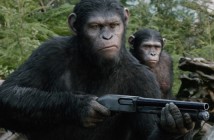It’s time to take stock of the past year in cinematic achievements. One category that was unfortunately absent from the Next Projection Awards was Best Ensemble, and here I am to rectify that oversight. While 2011 had no lack of great individual performances, it’s time to focus on how well entire casts came together. From the sprawling comic populations of Bridesmaids, The Muppets, Midnight in Paris, and Rango to the discordant families of The Tree of Life, A Separation, Warrior, and The Descendents; from the youth gangs of Attack the Block and Super 8 to the every-man-for-himself fractiousness on display in Contagion, Carnage, and Melancholia; the past year teemed with organizations, makeshift broods, and warring collaborations of all kinds. Post your Top Ten Ensembles of 2011 (remembering that we use IMDb dates here, so make sure your choices are from 2011) and see how they stack up to mine.It’s time to take stock of the past year in cinematic achievements.
10. The Ides of March
Although hefty with self-importance, George Clooney’s The Ides of March still boasts a bevy of forceful turns and tightly-wound exchanges. Its origins as the play “Farragut North” are plain and greatly benefit the solid cast, led by the relatively idealistic campaign staffer Ryan Gosling as he navigates the Machiavellian world of national politics. Philip Seymour Hoffman and Paul Giamatti duel over the telephone and in intense person as opposing campaign managers; they act like card sharps with Gosling as their hidden trump. Although underwritten, Evan Rachel Wood proves tragic as the love interest caught amidst scandal, and Marisa Tomei jets through scenes, verbally thrusting and parrying as a hounding New York Times reporter. The man at the top is director/co-writer Clooney as the Democratic candidate himself, a face enshrined on TV monitors and on posters until the plot gradually unfolds to Gosling’s disillusionment. Forbidding and constricting, the visual style aids in focusing on the character dynamics within the sturdy ensemble.
9. Septien
Michael Tully’s kind of Southern Gothic Septien is so singular that it’s hard to imagine anyone else playing the various roles, maybe because that are so very few roles much like them anywhere. Tully himself is the bearded, basketball-hustling prodigal son returning to a brood of bizarre misfits, including cross-dressing mother-figure Robert Longstreet and mad artist Onur Tukel. It only gets weirder from there, but it’s to the entire cast’s extreme credit that each assemblage of mannerisms and seemingly random details cohere at all into an identifiable, emotionally resonant character; even Mark Darby Robinson’s exasperatingly creepy plumber and John Maringouin’s itinerant preacher are far more interesting and multifaceted than they could have been under less well-performed circumstances. Harmony Korine’s wife Rachel provides a softening, inquisitive influence to the entertainingly loony proceedings, even as the psychological horror show builds towards an hysterical, cathartic climax.
8. The Day He Arrives
The reliable Hong tropes are in full force here: film directors, professors, critics, and students get together; they drink a lot; embarrassment, sex, and philosophical discussions drunkenly ensue. But Hong’s usual bifurcated structure instead takes the form of loose repetitions, coincidences, and variations that the characters even remark on at length; Kim Bo-kyung crucially portrays both an ex-girlfriend of the protagonist and a potential new one, leading a viewer to fruitfully compare and contrast recurring emotions and situations. The typically wide compositions and exorbitantly long takes capture two or more characters in breathing, evolving conversation, favoring the leading man no more than the fascinating supporting players. Even characters at the edge of the oft-frequented bar table, silent and sipping a drink, profoundly affect the dynamics within the ensemble, contextualizing it within the emotionally-fraught, close-knit Seoul film world Hong has so frequently revisited.
7. Midnight in Paris
Everyone wants to work with Woody Allen, and his bustling ensembles frequently feature an array of recognizable and up-and-coming faces. There’s typically a Woody surrogate, here burned-out screenwriter Owen Wilson, who finds himself magically transported to Paris in the 1920s. Midnight in Paris then boasts a collection of players embodying some of the early 20th century’s most important artists, with Kathy Bates as Gertrude Stein, Alison Pill as Zelda Fitzgerald, and especially Corey Stoll living up to the forcefully direct, masculine ideal of Ernest Hemingway, acquitting themselves best. The non-historical Marion Cotillard intrigues Wilson as much as his long-dead idols do, and much more so than the infuriating likes of Rachel McAdams and Michael Sheen from the present can muster. The seductive lure of nostalgia extends to Allen himself, leading to the name-dropping and conjuring of such luminaries as Djuna Barnes, Buñuel, Man Ray, Dalí, Eliot, and Cole Porter, making the film a kind of giddy wish fulfillment peopled with brilliant look-alikes.
6. I Wish
Buoyed foremost by the winning brothers Koki and Oshiro Maeda, I Wish is Hirokazu Koreeda’s warm, funny, emotional, and low-stakes look at two brothers’ quest to reunite via the new Kyushu bullet train. Although much less dramatic and more lighthearted than the director’s earlier Nobody Knows, this film nonetheless shares with it a likeably naturalistic ensemble of young actors and a gift for a child’s-eye view of the world. Children and not adults are the ones with agency, communicating with each other to fix up their parents’ relationship and to take advantage of the wish-granting property of witnessing two opposite trains pass each other. Among the more seasoned performers, like Joe Odagiri and Kirin Kiki, the children look effortless, their dialogue and mannerisms improvisatory, and their emotional maturation from wanting fleeting, materialist desires to desiring something more substantive truthful and exhilarating.
5. Bridesmaids
Although the male roles, like the female ones in Apatow productions (to which Bridesmaids has been compared and who produced the film), are for the most part perfunctory and superfluous, that shouldn’t detract from the marvelous assemblage of comediennes on display. Anchored by the lived-in rapport between star and co-writer Kristen Wiig and her fellow Saturday Night Live alum Maya Rudolph, the film would already be wholly remarkable for its concern for female self-actualization and the range of jokes by, for, and about women; its willingness to venture into gross-out territory, mostly thanks to the boundlessly vulgar and energetic Melissa McCarthy, only compounds its uniqueness. That so much of an audience came to enjoy a romp featuring diverse personality types and experiences bodes well for the future of female-centric comedy.
4. The Tree of Life
In Terrence Malick’s sprawling Tree of Life, the actors are but part of the mise en scène, but their wide-ranging performances ground the film’s more esoteric and cosmic concerns about purpose and memory. Brad Pitt and Jessica Chastain are the father of “nature” and the mother of “grace,” providing guidance to their three children (Laramie Eppler, Tye Sheridan, and most importantly the extraordinary Hunter McCracken) in the physical and spiritual realms. McCracken and his fellow youths contributed to a banner year for young performers (see Attack the Block, I Wish, Super 8, Terri, Hugo, Hanna, The Kid with a Bike, and A Separation). Although post-production comments by Sean Penn made it clear that even he didn’t quite understand the nature of his role in the final product, his place as McCracken’s future self posits him as the projector of the film’s ocean of reminiscences and imaginings, a crucial kind of mental narrator. Even though he only indirectly interacts with the earlier narrative, his wanderings and musings reach his younger self across the gulf of time by way of Malick’s bravura filmmaking.
3. Attack the Block
More entertaining and insightful than the more overtly Spielbergian Super 8, Joe Cornish’s Attack the Block examines a tight-knit clan of adolescents navigating extraterrestrial goings-on and traversing around their comfortable social sphere. That this gang of youthful kids from the projects is first introduced mugging their eventual compatriot Jodie Whittaker shows that the film isn’t afraid to dispense with sheer likeability; their eventual coming together (along with Luke Treadaway’s put-upon pot-smoking twenty-something) makes it clear that common humanity counts for more than race, class, or gender when the stakes are high. The young people (composed essentially of John Boyega, Alex Esmail, Franz Drameh, Leeon Jones, and Simon Howard, although all the youth performers deserve recognition) make for a rousing team of renegade block-defenders, alternately heroic when called and otherwise suitably improvisatory and laid-back. Much fun comes from Nick Frost’s glorified cameo and Jumayn Hunter’s menace, not to mention the eerie, low-budget visual effects, but it’s the core constituency of actors that makes Attack the Block an essential midnight movie.
2. Tinker Tailor Soldier Spy
A fine cast of both up-and-coming and eminently recognizable English actors brings to life John le Carré’s chilly, labyrinthine Tinker Tailor Soldier Spy. The lead is ostensibly Gary Oldman, whose stoicism takes a while to melt into action and dialogue, but each man plays an integral part in the plot machinations. The two generations of British Intelligence agents play well against each other, even with the more earnest and emotionally open aspects of the younger Benedict Cumberbatch and Tom Hardy souring into the world-weary, cynical knowingness and authority exemplified by veterans Oldman, Ciarán Hinds, David Dencik, and Toby Jones, with Mark Strong and Colin Firth in between age- and experience-wise. Period clothing and props lend an air of authenticity to all the performances. Despite their general lack of screen time, the two most notable women in the cast, Kathy Burke and Svetlana Khodchenkova, still get some indelible moments to grace the film with wit and pathos, qualities suitably lacking in the icy male performances.
1. A Separation
The dissolution of one Iranian family ripples out to affect many more aspects of society. Leila Hatami and Peyman Moaadi are arresting as the divorcing couple, with director Asghar Farhadi’s daughter Sarina (my choice as Best Supporting Actress in this year’s Next Projection Awards) the heart, soul, and future of the story. No less mesmerizing are Shahab Hosseini and Sareh Bayat as the couple who falls into the plot’s orbit by alternately caring for Moaadi’s Alzheimer-suffering father. At least a part of the greatness of their performances lies in both universality and specificity, grounding in the basest kinds of human emotions while fruitfully investigating the the limits of Iranian culture itself. In the best tradition of Renoir’s dictum “Everyone has their reasons,” the various characters suffer from the common vicissitudes of humanity; yet their actions and excuses become understandable but intractable as the film unfolds. Rarely has the dramatic stuff of day-to-day life been presented so heartbreakingly or naturalistically.




